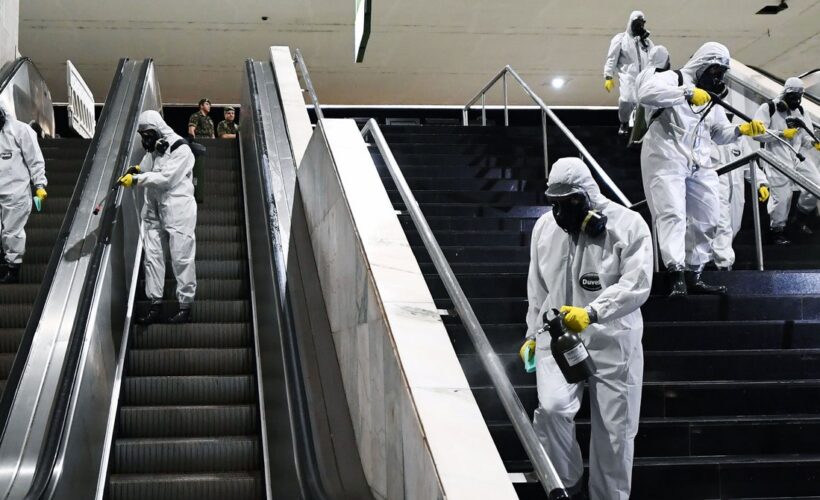It’s been well over a year since the first known case of coronavirus surfaced in China, the threat of the virus overtook normal life stateside, and phrases like “social distancing” and “contact tracing” became lodged in our collective vocabulary. From unemployment statistics to drug trials, new information about this pandemic emerges constantly, and dozens of theories about the disease get advanced or disproven on any given day. As the second pandemic summer progresses, questions loom large about everything from the Delta variant’s spread to what vaccine outreach to children will look like. We’ve put together a guide to everything you need to know about this pandemic—be it how to keep your children entertained or how this outbreak is affecting the economy. We’ll be updating it regularly to help you keep track of all aspects of this ever-evolving situation.
Basic Background
What the coronavirus is, and when it became a pandemic
The 2019 coronavirus is one of hundreds we know of, and one of seven known to infect humans. These viruses affect the lungs and also cause fever and sometimes gastrointestinal problems. The World Health Organization declared the coronavirus situation a global emergency in January 2020 and a pandemic in mid-March. The pandemic will likely end, but some experts now say it’s possible the virus will become endemic and stick around in a less lethal form. We don’t know exactly when and how the virus jumped from bats to humans, though efforts are underway to trace SARS-CoV-2 back to its origins.
Covid-19 symptoms
The most common symptoms of Covid-19 are dry cough, fever, and shortness of breath. Others include diarrhea and loss of smell or taste. Some people develop severe blood clots. The disease is mercurial—fairly mild for some and fatal for others. Scientists can’t say definitively why, but women are less likely to die than men. We know that older people, especially those with underlying health issues, are more at risk. And children fare better than adults, but for babies, toddlers, and kids with other conditions the disease can be severe. On the long road to recovery, people have experienced “brain fog”, heart issues, and a spate of other long-haul problems.
Social distancing and safety issues
Social distancing is about staying away from other people for long enough to slow the spread of the virus. When you do have to be near others, like at the grocery store, while delivering food, or going for a walk, the Centers for Disease Control and Prevention recommends staying 6 feet away. To enforce this, many states have implemented shelter-in-place orders at points throughout the pandemic. As places have started to reopen—and rolled back reopening plans—everyone has questions about what’s safe. You should still avoid travel, especially by airplane, if you haven’t been vaccinated. Scientists are still trying to figure out exactly how the virus spreads through air, especially in dense cities. To navigate life amidst the pandemic, some public health experts have also made color-coded guides. But there’s no foolproof way to calculate risk. The only way to avoid spreading Covid-19 is to follow all of the public health guidelines we have as much as possible.
How long coronavirus lasts on surfaces (and how to disinfect them)
We now know that you’re far more likely to get coronavirus from shared air than a shared surface. That said, it’s not a bad idea to regularly clean and disinfect high-touch belongings and surfaces like doorknobs, remote controls, and counters. One of the most important things you can do, of course, is wash your hands! You’ll want soap or disinfectant. You can also make your own sanitizer at home.
Wearing and making masks
The CDC recommends wearing a mask if not doubling up in public places where social distancing measures are hard to maintain, especially if you haven’t been vaccinated. They’re a must-have, and here are a few of our favorites. When you’re stocking up, remember that not all masks were created equal. You should layer a disposable surgical mask beneath a fabric face covering. Here are our tips for making a cloth outer mask—all you need are a t-shirt and two rubber bands.
New virus variants
All viruses mutate over time, as they spread from person to person. The novel coronavirus is no exception, but recently several new strains have emerged that seem to be more infectious, notably the Delta variant, now the dominant strain in the US. The good news is that, so far, the vaccines we have are still largely effective at protecting against these new variants. And not all variants are cause for alarm. As scientists boost genetic sequencing to trace these and other mutations more effectively and vaccination drives continue, the advent of these strains means it’s more important than ever to abide by social distancing guidelines.
Testing, Treatment, and Vaccination
The latest testing updates
At times, especially over the holidays, many people have operated on the assumption that a negative test means it’s safe to gather with others. But as we know from last fall’s superspreader event at the White House, we need to do more than just test to keep the virus from spreading. And even the test results themselves don’t necessarily account for the nuances of the disease.
Covid-19 treatments
At the moment, there’s no definitive treatment for Covid-19. Some researchers investigated chloroquine, the malaria drug touted by President Trump, but there’s no evidence that it’s a viable treatment. Others looked into using an anti-influenza drug and Crispr to treat the disease. The antiviral Remdesivir may also be helpful, though expensive. The hope is that research will find old drugs effective for treating Covid-19, thereby simplifying the drug discovery process. All in all, though, Covid-19 drug research has proven to be pretty messy.
For the time being, generic drugs could be helpful for those battling Covid-19. Blood from recovered patients also showed some promise. Though we don’t know exactly how effective it is, and getting it to those in need is a challenge, the Food and Drug Administration has OK’d its emergency use. Researchers are also investigating antibodies from the rare people who seem to have strong defenses naturally in place. And AI is being used to accelerate everything from diagnosis to drug discovery. Most of all, it’s important to remember that finding treatments takes time, and there are a lot of dubious theories circulating online. Whatever you do, please don’t try drinking bleach.
Vaccine development
In December, the US approved its first two Covid-19 vaccines, from Pfizer-BioNTech and Moderna. This was a blazingly fast scientific achievement, all the more so when you consider that both are the first-ever approved vaccines that use mRNA to train the immune system to recognize and fight off SARS-CoV-2. Though very few serious adverse reactions have been reported, many people experience side effects, typically a day or two of feverlike symptoms. The fact that these vaccines were authorized for emergency use could have some bearing on the fate of their ongoing trials. And now that they’ve been approved for use in adults, teens, and tweens, trials for children are underway. In late February, the FDA also approved a third vaccine, from Johnson & Johnson. Though it paused the vaccine’s use for a short time in April due to concerns about rare blood clots, the shot is now back in use, as its benefits outweigh the risks.
Meanwhile, trials for a number of other vaccines are ongoing. This is a good thing: We’ll need many vaccines to inoculate everyone, and it’s always possible that vaccines in trials now may prove even better than the ones we already have. Now that more and more new variants are emerging, research has also begun to figure out how to update existing shots, and to discern the effects of these vaccines on different people over time.
Vaccine rollout
Where rollout is concerned, two questions have loomed large: What order should people get the vaccine in, and how can they get vaccinated as efficiently as possible? Two of the three shots approved for use in the US right now, from Pfizer-BioNTech and Moderna, require two doses and must be stored at very cold temperatures, two factors that have complicated distribution. There’s also the issue of supply. At times, many Americans have had difficulty figuring out when they’re eligible and scheduling an appointment. Some experts have floated the idea of setting up mass vaccination clinics, but even this wouldn’t fully address issues of equity and access. Distribution plans disproportionately favor people with time and internet access, often sidelining those most in need. On top of all this, there’s the importance of building trust among the vaccine-hesitant, especially within communities that have historically borne the brunt of medical racism. One solution that seems to work: Vaccine lotteries. For the pandemic to truly end, even vaccinated people need to take precautions and everyone worldwide will need access to vaccines.
What to do if you or a relative is ill
Whether you’re raising a family or living alone, it’s best to isolate at home and keep your space clean. And whether you’re sick or healthy, it’s important to look after your mind and body.
Epidemiology and Tracking
How Covid-19 spreads
We know that the virus is passed from person to person when someone coughs or sneezes. Germy dust could also be a disease vector. Outbreaks spread exponentially at first but that rate slows over time, especially if additional measures are taken to flatten the curve. And some researchers are exploring the possibility that the virus could return seasonally like the common cold. Flu season was a nonevent during the pandemic, which means that our measures for curbing spread work, and also that [future flu seasons] (https://www.wired.com/story/covid-lockdowns-prevented-other-infections-is-that-good/) could be worse than we’re used to.
How other countries have handled it
Some countries opted for strict lockdowns. Others, like South Korea, Singapore, and Taiwan, seemed to have squashed the curve early on thanks to widespread testing and tracing efforts. Though travelers coming from the US and Europe later spurred an increase of cases, there’s still a lot for the US to learn. As far as disseminating information, censorship and misinformation have proven to be issues worldwide.
How coronavirus is being tracked
To build useful models and fully understand the coronavirus, we need to know how it has spread. Lots of countries are either using smartphone apps and location data to track the spread of the virus or are working to put a contact tracing system in place. To mitigate concern that this contact tracing would be an infringement of privacy, companies like Apple and Google collaborated on a Bluetooth-based system that would track coronavirus and notify people who have been exposed without surveilling users.
Beyond smartphones, some countries and workplaces have started using thermal cameras to detect potential fevers, and wearable devices and sewage surveillance may also prove helpful. In some places, the QR code is having its moment. And some city and state officials are skeptical about digital tracing, employing thousands of people to do the tracing instead. At the federal level, there has been talk of creating a national pandemic prediction agency to study Covid and get ahead of future pandemics.
Source:WIRED











